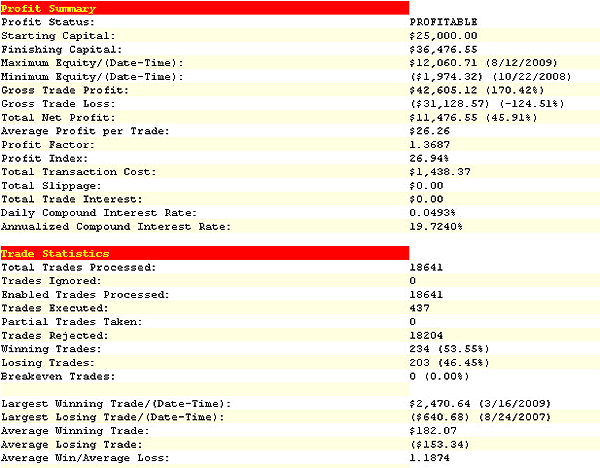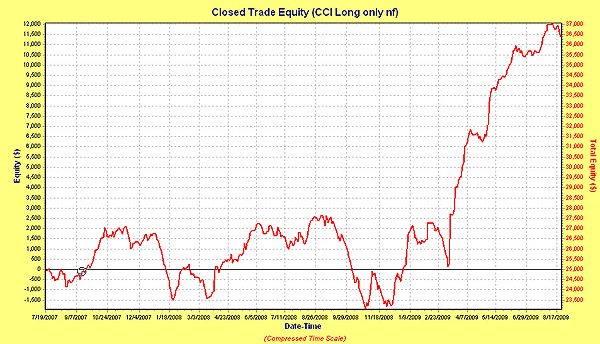
HOT TOPICS LIST
- MACD
- Fibonacci
- RSI
- Gann
- ADXR
- Stochastics
- Volume
- Triangles
- Futures
- Cycles
- Volatility
- ZIGZAG
- MESA
- Retracement
- Aroon
INDICATORS LIST
LIST OF TOPICS
PRINT THIS ARTICLE
by Donald W. Pendergast, Jr.
Designing a winning trading system, one that can survive a bear market as well as thrive during a bull market, takes a great deal of planning, testing, and self-examination.
Position: N/A
Donald W. Pendergast, Jr.
Donald W. Pendergast is a financial markets consultant who offers specialized services to stock brokers and high net worth individuals who seek a better bottom line for their portfolios.
PRINT THIS ARTICLE
TRADING SYSTEMS
Designing A System To Survive A Bear Market
08/18/09 08:50:03 AMby Donald W. Pendergast, Jr.
Designing a winning trading system, one that can survive a bear market as well as thrive during a bull market, takes a great deal of planning, testing, and self-examination.
Position: N/A
| You're going to be shown the essential building blocks of a trading system that looks like it's just too simple to be successful in the real world. It uses just one indicator, trades from the long side only, and has returned nearly 20% annualized since mid-July 2007, which was about the time that the Russell 2000 index peaked before the proverbial bottom fell out in the autumn of 2007. While it didn't return much profit during the bear market, it didn't lose much either, preserving trading capital for deployment during the powerful bull market rallies that have appeared since March 2009's historic market reversal. Here's what the real key to this system's success actually is. |

|
| FIGURE 1: MONTHLY HISTOGRAM. Here's a monthly histogram (percentage returns) for a simple CCI-based, long-only stock trading system. The use of a simple market timing filter would likely have reduced the extreme drawdowns experienced in January 2008 and October 2008. |
| Graphic provided by: Compuvision's TradeSim Enterprise. |
| |
| For those of you who use MetaStock, here's a MetaStock exploration code to locate new long trading signals and/or long trade exit signals, exactly as used in this article: Column name: Close Col A: CLOSE Column name: Long Col B: Cross( CCI(7),-100) Column name: Exit Col C: Cross( CCI(7),100) Filter: none I ran this simple MetaStock code on a diverse group of 150 mid- and large-cap stocks from every significant industry group, backtesting them from July 13, 2007, through August 17, 2009. While the system isn't the oft-searched-for holy grail, it lost very little money during the worst part of the 2007-09 market debacle and has demonstrated terrific performance characteristics since March 2009, when the bull market came back to life again. For testing purposes, initial equity was set at $25,000, and commissions were set at $0.008 per share of stock. A maximum of nine stock positions could be held at any time and only one new position could be added on any trading day, no matter how many trading signals were generated. An 11% fixed initial stop was used on every trade; no trailing stop was employed. Using this simple trade-sizing/money management plan ensured that the maximum account risk per trade was kept at approximately 1.25%, including commissions. In Figure 1, you can see how this simple momentum system performed on a monthly percentage returns basis. Despite taking major hits during January 2008 and then again in October 2008 (-9.84% and -11.09%, respectively), the system made money overall. The best month was March 2009, generating a 16% monthly gain; several other months also posted very healthy returns. Drawdowns were modest (coming in at only -12.23%, during January 2008), especially considering the severity of the recent bear market, which was the worst one since the Great Depression of 1930-33. All in all, a remarkable performance from a system that is deceptively simple. Are you're wondering why I didn't test the system in reverse (to allow short trades)? Here's why. I have yet to meet a nonprofessional trader who can consistently make money shorting stocks using a mechanical system over the long term. Not that it can't be done, I'm sure it has, but it is a rare individual who can keep it all together to enable such an atypical outcome. The reasons for not shorting stocks are many -- dividend liabilities, short-squeeze panics (watch out at earnings season for these), the natural bias of higher equity prices due to the long-term inflationary effects of the monetary system, and so forth. For most average traders, it's much wiser to just go to cash during confirmed bear markets, leaving the short-selling heroics to those with much deeper pockets. |

|
| FIGURE 2: VITAL STATS. Any long-only equity system that can survive the bear markets of 2007-09 and still produce a set of trade stats like this is deserving of further consideration by aspiring system builders and traders. |
| Graphic provided by: Compuvision's TradeSim Enterprise. |
| |
| In Figure 2, you can see the vital stats for this system; there were 437 trades (yes, this is a very short-term system), the win ratio was 53.55%, the profit factor was 1.37, the average winner was $182.07, and the average loser was $153.54. Maximum percentage drawdown was 12.23%. The system also had 11 consecutive winning trades and 17 consecutive losing trades; 314 of the 437 trades exited using the normal exit trigger, and 123 were stopouts (the stop was fixed at 11% on every trade). |

|
| FIGURE 3: TRADE EQUITY. Bear markets can be tough on any long-only system, but this one survived with only modest drawdowns. Note how rapidly the system made up those bear market losses once the markets finally began the reversal process between December 2008 and March 2009. |
| Graphic provided by: Compuvision's TradeSim Enterprise. |
| |
| Finally, here's the actual equity curve for the backtest run just described -- yes, it chopped around for many months (during the worst phase of the bear markets from July 2007 to December 2009), but again, the drawdowns on this hypothetical $25,000 trading account were very modest, given the severity of the selling panics in 2007-08 (Figure 3). The real selling point for this system is the powerful rise of the equity curve from December 2008 through early August 2009; this short-term commodity channel index (CCI)-based method is apparently well-suited to bull phases in the broad market, gaining about $13,000 (more than 50%) in eight months. So, here's your job: improve this system. Consider adding a market timing filter, one designed to keep you out of confirmed bear markets altogether. Maybe look at the volume characteristics of the stocks you wish to include in the system, particularly focusing on those from strong relative-strength sectors and industry groups. Maybe you could create a trailing stop, one that could lock in a higher amount of profits, or try adding two new stock positions a day instead of only one. The possibilities are endless; those who have MetaStock, TradeStation, or AIQ Trading Expert Pro should have little problem improving upon this basic momentum system, given the amazing amounts of technical firepower available in each program. (PS: I do believe there is a place for short-selling stocks and futures on a case-by case discretionary basis; I do that on occasion, and usually with good success, but almost never with a mechanical system.) |
| Here's a final thought for those endeared with the idea of creating and deploying a winning trading system -- the money management and trade-sizing aspects of the system are actually more important than the raw technical trading signals. Did you note that this system only adds one new long position on any given day, regardless of how many long signals the system fires (it tracks 153 stocks, so a day with 10 or even 20 signals isn't that unusual)? Do you see how adding new positions at a conservative rate can help keep your trading account protected from a sudden reversal that could wipe out a large chunk of your trading capital, particularly during bear markets? What if you added nine new long trade entries in one day, a day in which the broad market sees you coming and says, "Let's drop everything by 5% today, to punish Smedley the System Builder?" Would you rather have only put on one long position that day or have suffered a major drawdown as all nine of your stock positions took a major hit? Having the smaller position, one that you gradually build over time as additional long trade signals are developed, is the preferred course of action in virtually all cases. So there you have it -- playing a good defense (conservative position sizing and portfolio management) is even more important than uncovering a magic oscillator or even a top-secret trade entry strategy. |
Donald W. Pendergast is a financial markets consultant who offers specialized services to stock brokers and high net worth individuals who seek a better bottom line for their portfolios.
| Title: | Writer, market consultant |
| Company: | Linear Trading Systems LLC |
| Jacksonville, FL 32217 | |
| Phone # for sales: | 904-239-9564 |
| E-mail address: | lineartradingsys@gmail.com |
Traders' Resource Links | |
| Linear Trading Systems LLC has not added any product or service information to TRADERS' RESOURCE. | |
Click here for more information about our publications!
Comments
Date: 08/18/09Rank: 5Comment:
Date: 09/01/09Rank: 5Comment:

|

Request Information From Our Sponsors
- VectorVest, Inc.
- Executive Premier Workshop
- One-Day Options Course
- OptionsPro
- Retirement Income Workshop
- Sure-Fire Trading Systems (VectorVest, Inc.)
- Trading as a Business Workshop
- VectorVest 7 EOD
- VectorVest 7 RealTime/IntraDay
- VectorVest AutoTester
- VectorVest Educational Services
- VectorVest OnLine
- VectorVest Options Analyzer
- VectorVest ProGraphics v6.0
- VectorVest ProTrader 7
- VectorVest RealTime Derby Tool
- VectorVest Simulator
- VectorVest Variator
- VectorVest Watchdog
- StockCharts.com, Inc.
- Candle Patterns
- Candlestick Charting Explained
- Intermarket Technical Analysis
- John Murphy on Chart Analysis
- John Murphy's Chart Pattern Recognition
- John Murphy's Market Message
- MurphyExplainsMarketAnalysis-Intermarket Analysis
- MurphyExplainsMarketAnalysis-Visual Analysis
- StockCharts.com
- Technical Analysis of the Financial Markets
- The Visual Investor
